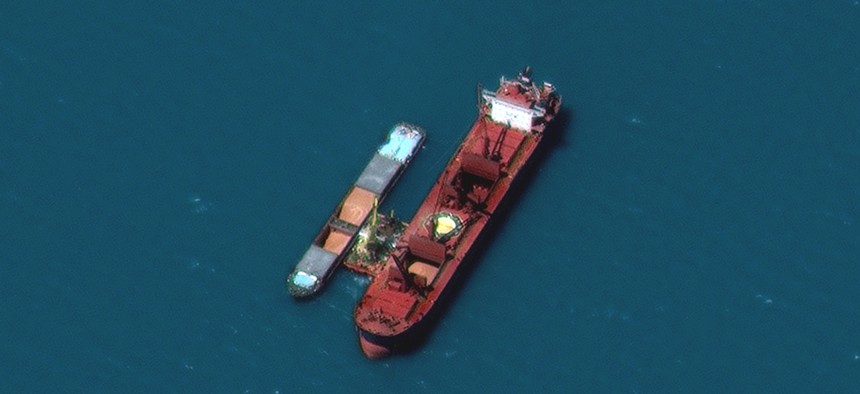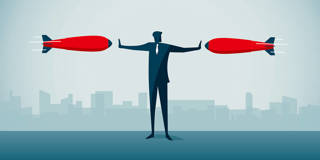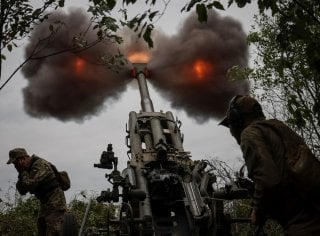It's the microchips that look set to get Vladimir Putin in the end. Six months into its invasion of Ukraine, Russia is being throttled by a severe technology deficit inflicted by sanctions.
Having fired off (or lost in combat) way more of their missile firepower than they originally anticipated, Moscow's soldiers are now increasingly relying on ancient stocks of primitive Soviet-era munitions while Western-armed Ukrainian forces are battling to turn the tide in a southern counteroffensive with pinpoint strikes on munition dumps and key infrastructure such as bridges.
Kyiv is acutely aware that the outcome of the war is likely to hinge on whether Russia finds a way to regain access to high-tech chips, and is out to ensure it doesn't get them. In order to flag the danger, Ukraine is sending out international warnings that the Kremlin has drawn up shopping lists of semiconductors, transformers, connectors, casings, transistors, insulators and other components, most made by companies in the U.S., Germany, the Netherlands, the U.K., Taiwan and Japan, among others, which it needs to fuel its war effort.
POLITICO has seen one of the Russian lists, which is divided into three priority categories, from the most critical components to the least. It even includes the price per item that Moscow expects to pay, down to the last kopeck. While POLITICO could not independently verify the provenance of the list, two experts in military supply chains confirmed it was in line with other research findings about Russia's military equipment and needs.
At first glance, Russia shouldn't be able to acquire the most sensitive tech on the lists. With only very basic domestic technology, the Kremlin has relied on key players in the U.S., the EU and Japan for semiconductors as suppliers over the past years and these should be out of grasp thanks to sanctions. The difficulty would emerge in whether an intermediary country such as China were to buy technologies, then sell them on to Moscow. In extreme cases, Russians appear to be clawing chips out of household appliances like fridges.
Ukrainian Prime Minister Denys Shmyhal stressed the war had come to an inflection point where the technological edge was proving decisive.
“According to our information, Russians have already spent almost half ... of their weaponry arsenal," he told POLITICO.
He added that Ukraine estimated that Russia was down to just "four dozen" hypersonic missiles. "These are the ones that have precision and accuracy due to their microchips. But because of sanctions imposed on Russia, the deliveries of this high-tech microchip equipment ... have stopped and they have no way of replenishing these stocks.”
Chips on the menu
Of the 25 items Russia is seeking most desperately, almost all are microchips manufactured by U.S. firms Marvell, Intel, Holt, ISSI, Microchip, Micron, Broadcom and Texas Instruments. Rounding out the list are chips by Japanese firm Renesas, which acquired the U.S.-based IDT; Germany's Infineon, which acquired U.S.-based Cypress; microcircuits by American firm Vicor; and connectors by U.S. firm AirBorn. Some of the items can be easily found in online electronics retailers, while others have been out of stock for months as a result of the
global microchip shortage.
The cheapest item on the top priority list, the 88E1322-AO-BAM2I000 gigabit ethernet transceiver made by Marvell, can apparently be sourced by Moscow for 430.83 rubles a piece, or around €7. The most expensive item, a 10M04DCF256I7G field programmable gate array made by Intel, can be sourced at a highly inflated 66,815.77 rubles or €1,107 each, according to the list (before the chips shortage, it would have cost under €20).
James Byrne, director of open source intelligence and analysis at leading defense and security think tank RUSI, said it's likely that Russia has been buying up stock of Western microchips and other essential equipment for years, but could now be running low.
The Russian military procurement program is "extensive, it’s well funded, and they have a huge military and industrial base producing stuff," said Byrne. "But now they’ve expended so much of it in Ukraine, they need a large volume of new supplies. And the sanctions will make it more difficult for them ... So they will have to prioritize critical things, and that’s why we’re seeing these documents. We obviously think they are scrambling to secure supplies."
Holes in the blockade
Since its latest invasion of Ukraine in February, Western countries have tightened sanctions on Russia, increasingly targeting its supply chains of microchips to decrease its military capabilities. The new sanctions come on top of years of stricter controls of chips sales — which often fall under "dual-use goods" because they're used in military and civilian applications alike — under international agreements like the
Wassenaar Arrangement as well as
recent EU law.
Experts warn that these export control regimes too often fail to stop transfers of technology to unwanted actors and entities.
"Once chips have left the factory it's very hard to know for sure where they end up," said Diederik Cops, a senior researcher in arms exports and trade at the Flemish Peace Institute, a research organization linked to the Flemish parliament.
Cops said Russian entities supplying the military have various ways to acquire critical goods, ranging from buying them on unregulated online marketplaces to using third-party front shops and post-box companies to smuggle high-tech kit into the country.
"Countries like North Korea and Iran have built up years of expertise to circumvent sanctions. Russia will surely have prepared itself to cope with this in past months ... The Russians can also rely on historic expertise to set up such channels: It was routine during the Cold War. And it has long borders with neighboring countries and a large network of allied states to work with," Cops said.
The U.S., Europe and other Western allies have set up licensing regimes to stop companies from exporting potential military technology to clients who could be deemed a risk to their security. But "it's a huge challenge to monitor the illegal proliferation channels, and even the legal channels, to see who the end user is," Cops said.
The sanctions imposed since February's invasion aimed to close loopholes and further tighten the screws on Russia's military.
According to Damien Spleeters, deputy director of operations at Conflict Armament Research (CAR), an organization specialized in tracking and tracing weapons of war that is currently tracing components found on Ukraine's battlefields, it's too early to say to what extent the sanctions are working: "Everything we've seen so far was produced before the invasion. It's stocks that date from before the sanctions," he said.
But the Russians are definitely “running out of stock," according to Ukraine's Prime Minister Shmyhal. "They are using their Soviet-made equipment and missiles which were produced back in 1960s or 70s," he said.
Russia is so desperate for the most sophisticated semiconductors for its weapons program, it has resorted to stripping microchips from dishwashers and fridges to use in its military gear, U.S. Commerce Secretary Gina Raimondo
said in May, attributing the intel to Ukrainian officials.
But some American national security veterans disagree with the optimistic assessment from U.S. President Joe Biden’s team. They say Western governments have little ability to stop other regimes — particularly China — from transferring microchips to Russia.
The controls on chips “are about as tight as a screen door,” said Matthew Turpin, the U.S. National Security Council director for China from 2018 to 2019. “China and Russia share a 4,300-kilometer border. There is absolutely no way we could detect if those chips are passed from China to Russia.”
The U.S. Commerce Department has repeatedly said it has seen no evidence that China is transferring technologies to Russia, which could open Beijing to severe sanctions. But the Chinese government has also said it would put no new limits on its commercial relationship with Russia, and Turpin and others say there is almost no way Western governments can be certain of their behavior.
Commerce’s Bureau of Industry and Security, which oversees tech sanctions, has “fewer than 10 ‘inspectors’ in China which are supposed to determine whether chips have been diverted to Chinese military use,” Turpin said, adding that “we are not effective in inspections” because the Chinese government requires prior warning.
Desperate times, desperate measures
Over the past years, as its relationship with the West turned increasingly frosty, Russia implemented an import substitution program, seeking to create its own high-tech industry. Those efforts have become ever more urgent now.
Russia's ministry of industry and trade has prepared proposals that seek to further incentivize local companies to produce the high-tech components needed by the military-industrial complex, business daily
Vedomosti reported last month. The measures, dated August 22, include slashing tax for the relevant companies, reducing insurance premiums, providing preferential loans and guaranteeing purchases. The measures are due to be approved and enter into force no later than January 1, according to Vedomosti.
The problem for Moscow is that such measures have failed in the past, bogged down by widespread corruption and graft, not to mention
a brain drain — and that's unlikely to change now.
"Ultimately it hasn’t really been a success," RUSI's Byrne said about Russia's import substitution drive. "There’s loads of high-tech components they can’t replace with home-made alternatives ... A lot of those things are absolutely critical for their weapons program."
An August investigation by Reuters with RUSI showed components of U.S. and other Western technology firms were still rife in Russian military equipment found on the battlefield.
Such Western components, and microchips in particular, are key for Russia's military to keep up its war efforts.
"Russia's missiles, processing computers, and sensors are built with Russian parts. But the most critical components in them, the highest tech, were Western," RUSI's Byrne said. "The Russians have used a lot of their high-end equipment — cruise and ballistic missiles, precision munitions, the latest infantry fighting vehicles. Now, they're resorting to older equipment they’ve brought out of storage. And part of the aim of sanctions is to slow down procurement of high-tech components, and essentially attrit the Russians’ ability to use this high-end stuff, so they will have to rely more and more on outdated equipment."
Cops, the Belgian researcher, said: "More and more 'dumb' rockets are being found in Ukraine, demonstrating how Russia is battling supply chain shortages."
Friends with benefits
While the EU, U.S., Japan and other countries have slapped sanctions on Russia, Moscow has a friend in Beijing, which has already provided the country with off-road vehicle exports for command personnel, drone components, and naval engines. But like Russia, China has also struggled to catch up with its competitors when it comes to the most high-tech components Russia needs.
"A lot of these [Western] companies, they’re really specialized in the specialized kit, they’ve been making it a long time. The Chinese semiconductor industry doesn’t have capability to make those things," RUSI's Byrne said.
Kevin Wolf, former assistant secretary of commerce under the Obama administration, said China’s difficulties in access indicate new global norms, as countries around the world coordinate to put pressure on Russia.
“As horrible as the invasion of Ukraine is, one dramatic effect is the accelerated pace of the U.S. to work with its offshore allies to impose common controls outside of the regular regime process, that are especially painful to China given the state of their [semiconductor] industry," Wolf said.
National security concerns put Western industry between a rock and a hard place, as companies argue sales to China provide critical revenue to support their research and development efforts.
Above all, the wide use of Western tech in Russia's military equipment shows it's extremely hard to even understand the global arms trade, Spleeters, at Conflict Armament Research, said.
"Everything can be regulated … But you need to have an observation component to it," Spleeters said. "You need to monitor how it's being used, how it's being acquired. If you lack that vision on the field you risk missing a lot of the possible trade routes and ways to circumvent the rules."

:quality(100):focal(4102x1672:4112x1682)/cloudfront-us-east-1.images.arcpublishing.com/thesummit/TP3LTCVQ6RAADJKYMOEEZ5QHZM.jpg)












